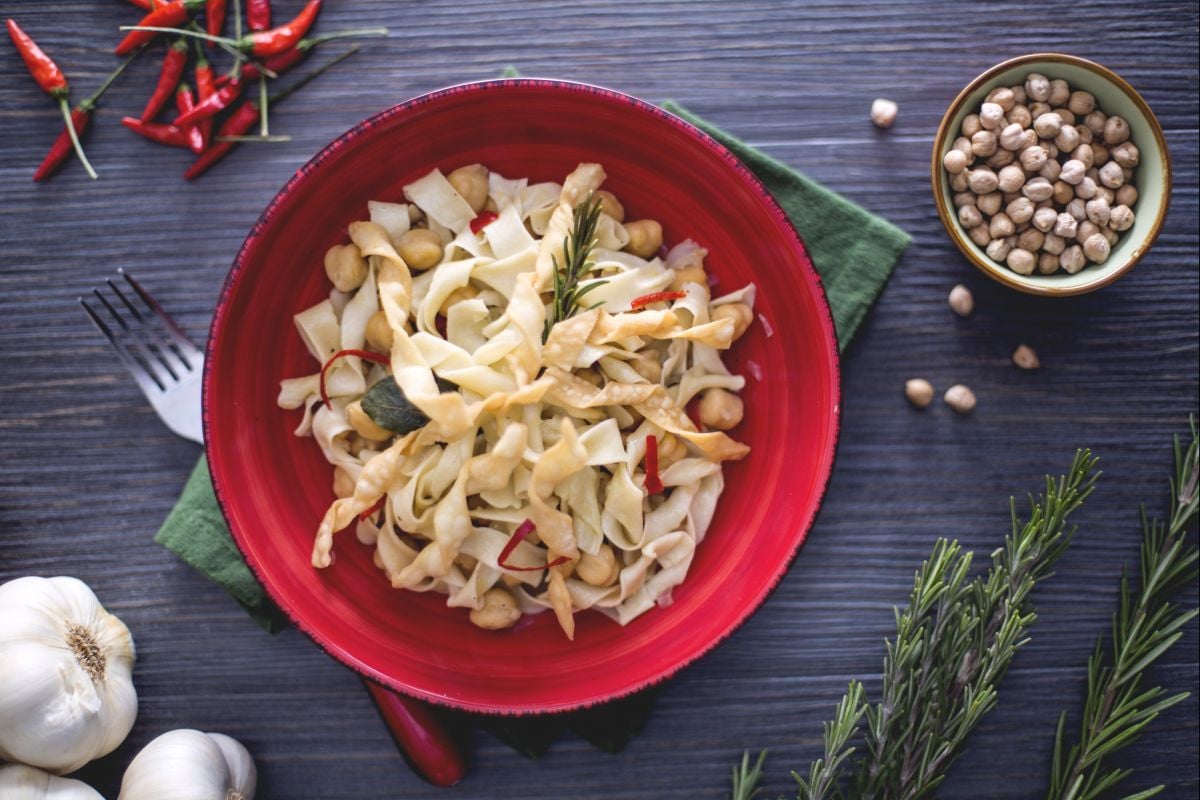Ciceri e tria

- Lactose Free
- Vegetarian
- Vegan
- Energy Kcal 610
- Carbohydrates g 81.3
- of which sugars g 5.3
- Protein g 17
- Fats g 24.1
- of which saturated fat g 3.31
- Fiber g 8.4
- Sodium mg 208
- Difficulty: Average
- Prep time: 50 min
- Cook time: 2 h 30 min
- Serving: 4
- Cost: Low
- Note + the soaking time for the chickpeas (1 night) and the resting time for the fresh pasta
PRESENTATION
Ciceri e Tria is a classic dish that puts Salento on the map for southern Italian cuisine. This traditional recipe really shines with its crispy twist. You get a mix of homemade pasta—some boiled, some fried until it's golden and crunchy—tossed with earthy chickpeas. And honestly, what makes the Ciceri e Tria recipe so special isn’t just the tender bites of pasta or the moist chickpeas, but those fried 'tria' spirals that snap with every bite. People in the Salento region of Puglia have been making this for ages—seriously, even Roman poets wrote about it back in the day! The name 'tria' actually comes from an old Arabic word, showing the cultural influences that shaped Salento cuisine over time. This isn’t your basic pasta and beans—there’s history, tradition, and a lot of really tasty texture going on.
In the traditional Italian pasta and chickpeas dishes from other regions, you won’t find this fried pasta twist. And here's the thing, the Salentino version is all about that mix: soft, chewy noodles, creamy chickpeas, and those crispy strips that make every forkful interesting. People in Puglia use a blend of regular flour and semolina for the dough, rolling it out thin and twisting it into funky shapes. It’s a proper Apulian pasta dish, fitting in perfectly with local favorites like tiella barese. These dishes really show off the variety in authentic Italian recipes from the region. Eating ciceri e tria is like taking a trip down south without leaving your house—you get those tangy flavors of olive oil, a hearty feel from the chickpeas, and a real taste of Mediterranean comfort food. It’s cucina povera at its best: simple, filling, and totally satisfying. And that extra crunch? Seriously good. Plus, it’s a great way to explore the rich culinary heritage of Puglia, where each bite tells a story of tradition and innovation. Whether you're a fan of pasta or just love trying something new, ciceri e tria gives you a delicious glimpse into the heart of Italian cooking.
You might also like:
INGREDIENTS
- Ingredients for fresh pasta
- Water 0.7 cup (165 g) - (at room temperature)
- Type 00 flour 1 ¼ cup (150 g)
- Remilled durum wheat semolina 1 ¼ cup (150 g)
- Extra virgin olive oil 1 spoonful
- For the seasoning
- Dried chickpeas ¾ cup (150 g)
- White onions 3 oz (80 g)
- Garlic 2 cloves
- Rosemary 3 sprigs
- Fresh chili pepper 1
- Extra virgin olive oil to taste
- Bay leaves 3 leaves
- Vegetable broth 1 ½ cup (350 g)
- Vegetable oil 1 cup (250 ml)
- Fine salt to taste
How to prepare Ciceri e tria

To prepare ciceri e tria, start by soaking the chickpeas in water the night before, so that the skins soften 1. Then, prepare the vegetable broth; then clean and finely chop the onion. Meanwhile, pour the oil and two whole peeled garlic cloves into a large pot 3

Remove the garlic as soon as it is well browned, then add the chopped onion and stir with a spatula 4; let it wilt over low heat adding water or vegetable broth so it does not stick to the bottom 5. After about 10 minutes, add the chopped chili pepper (making sure to remove the internal seeds), rosemary, and bay leaf 6.

Drain the chickpeas and add them to the pot (7-8) and salt to your liking: they should cook covered with a lid for about 2 hours, gradually adding vegetable broth 9.

In the meantime, work on the pasta: in a bowl sieve the all-purpose flour 10 and the re-milled semolina, then gradually add the room temperature water 11 and the olive oil 12

Mix with a fork while continuing to add room temperature water to the mixture (13-14); then knead by hand first in the bowl 15,

when it has compacted 16, you can continue to work it on a slightly oiled work surface 17, until you get a smooth and homogeneous dough, wrap it in plastic wrap 18, and let it rest for at least 30 minutes at room temperature.

After resting, take the dough and roll it out with a pasta machine using all the levels to create a 2-3 mm thick sheet (you can also use a long rolling pin) 19. Then change the machine head, to make tagliatelle 20 and then cut them into pieces of 3-4 inches in length 21.

Twist each piece of pasta to give it a spiral shape 22 and place the pasta on a sieve to dry for at least 2 hours 23. In a pot, bring the seed oil to a temperature of 340°F (to be measured with a kitchen thermometer); when the pasta has dried, fry 40% of the total (calculated on the total weight of the pasta), a few pieces at a time 24.

When they are well golden, drain them 25 and place them on a tray lined with paper towels 26. The remaining pasta can be boiled in plenty of salted water for about 1 minute 27.

Drain them by adding them directly to the pot with the now-cooked chickpeas 28, to flavor and mix it with the seasoning. Plate the pasta and chickpeas, garnishing with some fried tria 29; your ciceri e tria are ready to be enjoyed 30!